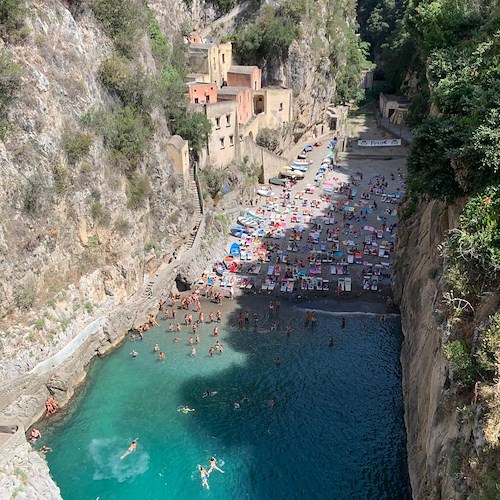You are here: Picturesque townsFurore, the enchanting "Village that does not exist" on the Amalfi Coast
Written by (Massimiliano D'Uva), Saturday, November 30, 2024 10:43:40 AM

Another gem of the Amalfi Coast, Furore derives its name from "the sound of the raging sea pounding against the valley below." Thanks to its unique physical and geographical location, it served as an impregnable stronghold during the Saracen invasions.
The fjord, one of the most picturesque in Italy, has long been a natural harbor. It was once a hub for flourishing trade and home to historic industrial sites like paper mills and water-powered mills.
Furore is also nicknamed "the village that does not exist" (Italy's Neverland) because it lacks a central hub. Instead, small clusters of houses dot the ridges of the cliffs, creating an enchanting yet unconventional setting. Its open-air art gallery, featuring over 100 murals and sculptures, makes Furore a true "painted village."
The municipal area encompasses the coastal fjord, bordering Praiano and Conca dei Marini, and extends inland up to an altitude of 600 meters above sea level, surrounded by the rugged mountains of Agerola.
Historically, Furore was a district of the Royal City of Amalfi. It was where exiles and outcasts were sent, banished to a remote, sparsely populated area unsuitable for farming. It is first mentioned in a 1752 land registry.
In the 1950s, Furore became the set of the famous film L'Amore and the stage for the passionate, stormy love affair between director Roberto Rossellini and renowned Italian actress Anna Magnani.
The village's most striking feature is its breathtaking scenery: terraced vineyards climbing the mountainside, lemon groves shaded by nets, red-roofed houses, colorful majolica-tiled bell towers, wild blackberry flowers, and the ever-present blue sea below.
Historical, Architectural, and Natural Highlights
Church of St. James the Apostle: Dating back to the 11th century and built on the ruins of an ancient rural church, it features a multi-story bell tower crowned by a spire of majolica tiles. Recent renovations revealed frescoes of the Giotto school, depicting scenes from the life of Saint Margaret.
Church of St. Michael the Archangel: This Baroque-style church is simple yet elegant, with three naves supported by baseless columns with modest capitals.
Church of St. Elias: Built in the 13th century in a suburb of the village, it houses a rare wooden triptych of the Madonna with Saints Bartholomew and Elias, painted in 1479 by Angelo Antonello from Capua.
Church of Santa Maria: A serene historical landmark reflecting the area's rich religious heritage.
Hermitage of Santa Barbara: A medieval monastic site now in ruins, hidden among the bushes near Santa Barbara's cave, once used by monks.
Fjord of Furore: A dramatic gorge carved into the rock at the mouth of a steep valley descending to the sea. Its tiny, picturesque fishing village is now home to an eco-museum with sections dedicated to paper-making, herbology, and the local cultural heritage. The fjord is spanned by a 30-meter-high bridge, part of the coastal road and the setting for the annual Marmeeting High Diving Championship each July.
Furore is a place where history, art, and nature converge, offering visitors a rare and unforgettable glimpse of the Amalfi Coast's less-trodden paths. From its colorful murals to its historical landmarks and breathtaking landscapes, this "village that does not exist" will leave a lasting impression.
 Agriturismo Sant'Alfonso
© Massimiliano D'Uva
Agriturismo Sant'Alfonso
© Massimiliano D'Uva
 Fiordo in winter time
© Massimiliano D'Uva
Fiordo in winter time
© Massimiliano D'Uva
 Fiordo in Summer time
© Massimiliano D'Uva
Fiordo in Summer time
© Massimiliano D'Uva
 Praia Furore - Praiano
© Massimiliano D'Uva
Praia Furore - Praiano
© Massimiliano D'Uva
 Agriturismo Sant'Alfonso Rainbow
© Massimiliano D'Uva
Agriturismo Sant'Alfonso Rainbow
© Massimiliano D'Uva
 Fiordo di Furore Winter Time
Fiordo di Furore Winter Time
rank: 100012103
"Words can hardly describe the sunset as seen from this place, where the great planet offers a surprising and unique effect of light; appearing like a glowing sphere descending slowly toward the horizon, into a vast sea that seems to be made of both fire and light, almost saluting with its final rays...
Perched on a rocky outcrop at 365 meters above sea level, Ravello sits in the heart of the Amalfi Coast, overlooking the entire Gulf of Salerno. It is one of the most beloved destinations along the "Divine Coast," thanks to its irresistible charm and worldwide fame—a perfect blend of art and music that...
The beauty of the Amalfi Coast never ceases to amaze, but there are moments when nature seems to outdo itself. This is the case with this stunning aerial shot, taken at dawn by Vietri-born photographer and entrepreneur Carlo De Felice, capturing the magic of the first light of day as it gently touches...
Land between the mountains ("intra montes" in Latin), Tramonti is a wonderful town on the Amalfi Coast, set at the foot of the Lattari Mountains and surrounded by a suggestive bucolic landscape consisting of about 145 acres of woods, terraces cultivated with lemon trees, olive trees, and vineyards. The...